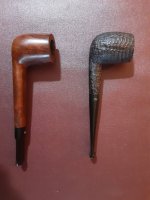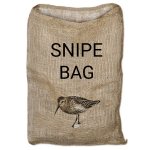Good things come to those who wait... ?Proverbs 22:6 brah. There’s still hope for me yet
Open Draw: Cob vs. Briar?
- Thread starter GothPiper
- Start date
You are using an out of date browser. It may not display this or other websites correctly.
You should upgrade or use an alternative browser.
You should upgrade or use an alternative browser.
SmokingPipes.com Updates
Watch for Updates Twice a Week
Interesting. But why does this only affect briars with wider draws/filters removed? Does clenliness of a pipe have any bearing on this?Lignin in the hardwood shanks of cobs alters the chemical make up of the tobacconite to a point of rendering in inert.
Nearly the same principle as the cob. The filter effectively absorbs the tobaccanite and the moisture from the smoke prevents it from drying and becoming unstable. Briar is non absorbent and the tobacconite remains on the surface of the mortise and cannot bind with the lignin where it dries and when exposed to heat can ignite.Interesting. But why does this only affect briars with wider draws/filters removed? Does clenliness of a pipe have any bearing on this?
This is some impressive scientific knowledge right here!Nearly the same principle as the cob. The filter effectively absorbs the tobaccanite and the moisture from the smoke prevents it from drying and becoming unstable. Briar is non absorbent and the tobacconite remains on the surface of the mortise and cannot bind with the lignin where it dries and when exposed to heat can ignite.
So if one were to, say, clean a filterless briar with a spirit on a regular basis, could that eliminate the boom boom?
(oops, looks like I posted this just as your next response came thru! Thanks!)
You can with water as well. It will dilute any harmful particles and remove them.So if one were to, say, clean a filterless briar with a spirit on a regular basis, could that eliminate the boom boom?
Thanks! Mastered in Bovine Scatological Science. Top of my class!This is some impressive scientific knowledge right here!
Sometimes, after the char light and tamp; on the relight a brief flame will pop up, as though caused by some sort of gas.
Could this be tobacconite, I wonder ?
You're right!!!!?Sometimes, after the char light and tamp; on the relight a brief flame will pop up, as though caused by some sort of gas.
Could this be tobacconite, I wonder ?
Lignin in the hardwood shanks of cobs alters the chemical make up of the tobacconite to a point of rendering in inert.
Lignin had been added to cobs just after the civil war. Too many casualties from non-lignin pipe explosions. — Men likely to catch a lead ball to the belly, knew well the risks of tobacconite — yet took the risk due to the relief that their pipes and tobacco offered.
Clenchers suffered the most horrific wounds when their shanks exploded. Better to risk a few fingers but, like I said. We all know the risks. Keep those pipes clean. Water rinse often. Stay safe out there, men.
Sometimes, after the char light and tamp; on the relight a brief flame will pop up, as though caused by some sort of gas.
Could this be tobacconite, I wonder ?
Correct, and this is actually a good thing, as it combusts moderate tobacconite deposits safely, before they build to more dangerous levels in the shank.
For years it was assumed that these little flares were due to combustibles released in the smoke of the fresh tobacco -- it wasn't till the late 90s that a Czech study linked them to combustibles accumulated in the shank (mainly tobacconite, although technically a few other compounds usually play a minor role as well).
Unfortunately, why exactly these flares decompress tobacconite density at moderate levels of accumulation in a safe direction, sometimes, and not at other times, is thus far little understood. That is the subject of an ongoing study, in hopes that we might develop techniques for controlling for them, and so render the increasingly popular "Jute Fiber Protocol" obsolete.
Suffice it to say that, until we get better answers on that, consider yourself blessed to experience such a safe flare -- it means that you dodged an eventual bullet.
Lignin had been added to cobs just after the civil war. Too many casualties from non-lignin pipe explosions. — Men likely to catch a lead ball to the belly, knew well the risks of tobacconite — yet took the risk due to the relief that their pipes and tobacco offered.
Clenchers suffered the most horrific wounds when their shanks exploded. Better to risk a few fingers but, like I said. We all know the risks. Keep those pipes clean. Water rinse often. Stay safe out there, men.
Yes, which is fairly well known, but what is not (for whatever reason) as well known is that the tobacconite neutralizing property of lignin was discovered by the personal physician to Jefferson Davis, after Jefferson had to remove Joseph Johnston from service (due to a tobacconite incident experienced in his tent, late one night, in Fair Oaks Station, Virginia).
This physician took on the growing tobacconite casualty problem as a personal project after treating Jefferson for the ulcers he was experiencing over it.
"We lose enough of our Southern Sons to the damned Yanks as it is!" Jefferson burst out, if the chroniclers have quoted him correctly, "We can't afford to lose our best and brightest to this exploding pipe business, too!"
Within 48 hours, his physician had made the lignin discovery (just how is a mystery lost to the sands of time), but the war was over by the time the cob manufacturers could implement it.
Tobacconite particles are usually in equilibrium, unless in the event of a syzygy the celestial gravitational lines cause a rapid non-equilibriative state to ensue— and blooey!
Tobacconite particles are usually in equilibrium, unless in the event of a syzygy the celestial gravitational lines cause a rapid non-equilibriative state to ensue— and blooey!
Good point, I had forgotten about that -- sometimes cosmic center-of-mass experiences minute oscillations due to irregularities in intra-gravitational relationships on the broadest scale. This can destabilize protons in Nicotiana Combustibilis (common "tobacconite") leading in minor cases to death and in serious cases to pipe damage.
Thank you for your explanation.Correct, and this is actually a good thing, as it combusts moderate tobacconite deposits safely, before they build to more dangerous levels in the shank.
For years it was assumed that these little flares were due to combustibles released in the smoke of the fresh tobacco -- it wasn't till the late 90s that a Czech study linked them to combustibles accumulated in the shank (mainly tobacconite, although technically a few other compounds usually play a minor role as well).
Unfortunately, why exactly these flares decompress tobacconite density at moderate levels of accumulation in a safe direction, sometimes, and not at other times, is thus far little understood. That is the subject of an ongoing study, in hopes that we might develop techniques for controlling for them, and so render the increasingly popular "Jute Fiber Protocol" obsolete.
Suffice it to say that, until we get better answers on that, consider yourself blessed to experience such a safe flare -- it means that you dodged an eventual bullet.
What I've decided to do, provided that I remember, is after the char light and tamp, to gently blow into the stem, hopefully clearing any tobacconite before I relight.
Until this thread I had never heard anything about it.
You can never, ever, be too careful!!Until this thread I had never heard anything about it.
As a further suggestion, Barber B-line pipes, which are in fact Dunhill seconds, have a very good draw, particularly the straights.I love, love, love the wide open draw on cobs (with the filter removed).
I want to find a briar with with a similarly open draw. Are there any briar brands that are especially known for having a more open draw?
Naturally, I thought of just getting a filtered briar and removing it; like I did with the cobs. But a couple of threads on here say that doing so could lead to an... explosion (?!). Why is this the case with briars, but cobs are immune? Or are they?!
They are available at smoke.co.uk Potential problem being US customs, but you could always message the company to ask if they've experienced any problems with shipping to the US.
They are lovely pipes. Maybe they are seconds, but I find no faults with them.
Here are two of my favorites, the Canadian or Lumberman has the most comfortable bit
 of any of my pipes.
of any of my pipes.And don't worry about all the tobacconite jokes. It is only intended to be a bit of fun.
I bought a pipe from Christopher pipes - Christopher Pipes - https://www.christopherpipes.com/index.htmlI love, love, love the wide open draw on cobs (with the filter removed).
I want to find a briar with with a similarly open draw. Are there any briar brands that are especially known for having a more open draw?
Naturally, I thought of just getting a filtered briar and removing it; like I did with the cobs. But a couple of threads on here say that doing so could lead to an... explosion (?!). Why is this the case with briars, but cobs are immune? Or are they?!
It has the draw of a cob and I love it! Plus he is a forum member too!
I think there are several people in this post that are full of Shittite!






